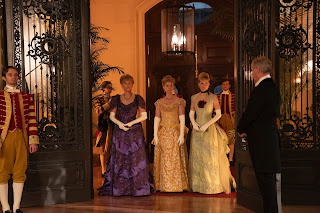Famous forever already as the creator of Downton Abbey, Julian Fellowes has now added to his résumé a new historical drama, The Gilded Age, set in New York during the so-called "Gilded Age," the boom years of 1880s. The series has nine episodes, the first of which, "Never The New," was aired on HBO last night.
It was the 1970s British series Upstairs, Downstairs that first set the standard for such enterprises. Downton Abbey, while very different in certain respects, reprised the Upstairs, Downstairs motif of an upper-class English family and their servants, going through the ordinary stresses of family life magnified by the complications of historical change. Both series spanned British history from the late Edwardian era through the traumatic experience of World War I to the 1920s. Both endeared themselves to their audiences through the incredibly interesting and well-played characters (both upstairs and down) as well as through the equally interesting experience of watching and epoch dramatic historical changes and the impact of those changes of a traditional way of life going from a social norm to a no longer normative relic of a bygone past, a pst not really missed in practice but much romanticized in theory.
Setting The Gilded Age in New York in the boom years of 1880s breaks that mold, no matter how many rich people, fancy houses, beautiful outfits, and servants still populate the screen. Fellowes, et al., have assembled a fantastic cast, who should be able to do wonders with this story. And perhaps they will. The first episode basically introduces everybody and the thematic storyline and leaves us wondering what more there is for them to do.
In a sense, The Gilded Age is ill-served by comparisons with either Downton Abbey or its illustrious predecessor Upstairs, Downstairs. First of all, it is not about actual aristocracy and all the deference that accompanies it, because it cannot be. It is set in the U.S., which however unequal a society simply did not have the appropriate feudal cultural inheritance. Secondly, whereas the more famous British series were about aristocracy in a slow process of historical decline, this series seems as much about a pseudo-aristocracy (the "old money" families with pedigrees back to colonial times) being replaced by an oligarchy of "new money." While the rise of the "middle classes" was an underlying Downton Abbey theme (e.g., Cousin Matthew's "middle-class" background and ideas, Lady Mary's unsuitable fiancé Richard Calysle, Lady Edith's lover Michael Gregson, etc.), The Gilded Age is inherently about the rise of the new class of plutocrats, who are more "middle class" in background and outlook compared with the "old money" they are displacing, who are, of course, less aristocratic than they pretend to be.
The Gilded Age recalls a real period in American history. Of course, what was ultimately much more interesting about the 'new money" dominance was not its displacement of a pseudo-aristocracy of "old money" but rather its destruction of whatever was left of the earlier egalitarianism of the colonial, founding, and Jacksonian eras. That would make a less interesting interpersonal drama. Hopefully, the series can make more interesting the alternative, if somewhat contrived, interpersonal drama of competition among complacent rich women resisting the rise of ambitious rich women.
Because this is HBO and because this is 2022, the series seems to be aiming at a more contemporary feel in regard to the range of issues addressed. Unlike Europeans, who have an authentic feudal heritage and hence understand class, Americans tend to resist acknowledging the reality of class and class conflict. Race. on the other hand, has been a conflict in American history from its beginning, and has often served as a surrogate for what might otherwise be class conflicts. The Gilded Age presents itself primarily as a class conflict within the ultra-rich, but very early on introduces the complex and fraught issue of race through the seemingly improbable friendship between two of the main characters, through whom we get to see some of the challenges and difficulties of being Black (albeit northern, somewhat middle-class Black) in post-Civil War ebulliently capitalist New York. Whatever the series will do with that dimension of the story, it has the potential to enrich the interactions of otherwise apparently one-dimensional characters. The same, potentially, for the series' (equally improbable) foray into sexual diversity in late 19th-century upper-class experience.
After only one episode, while aspects of the storyline are obvious and where individual characters are headed also seems obvious, it remains to be seen how they will be developed and what surprises may still be in store.
(Photo: The New York Times)


No comments:
Post a Comment